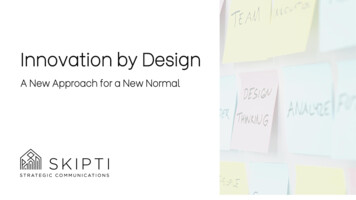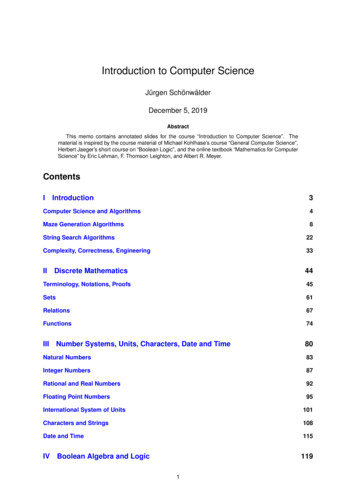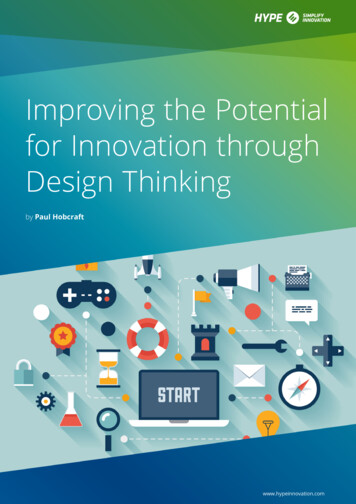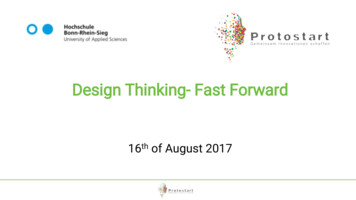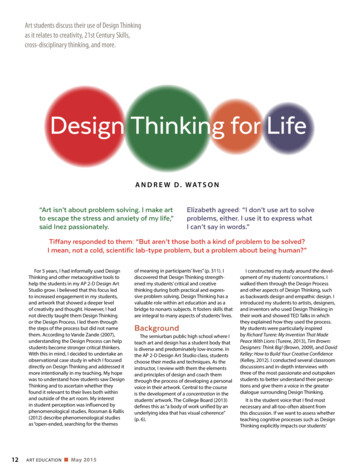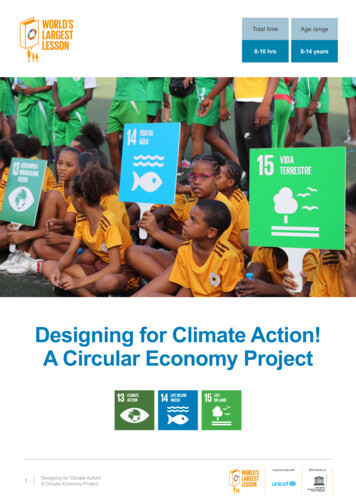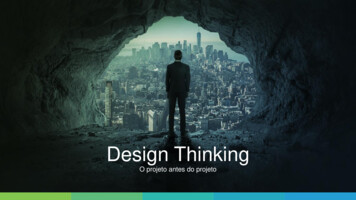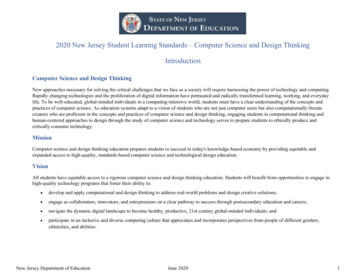
Transcription
2020 New Jersey Student Learning Standards – Computer Science and Design ThinkingIntroductionComputer Science and Design ThinkingNew approaches necessary for solving the critical challenges that we face as a society will require harnessing the power of technology and computing.Rapidly changing technologies and the proliferation of digital information have permeated and radically transformed learning, working, and everydaylife. To be well-educated, global-minded individuals in a computing-intensive world, students must have a clear understanding of the concepts andpractices of computer science. As education systems adapt to a vision of students who are not just computer users but also computationally literatecreators who are proficient in the concepts and practices of computer science and design thinking, engaging students in computational thinking andhuman-centered approaches to design through the study of computer science and technology serves to prepare students to ethically produce andcritically consume technology.MissionComputer science and design thinking education prepares students to succeed in today's knowledge-based economy by providing equitable andexpanded access to high-quality, standards-based computer science and technological design education.VisionAll students have equitable access to a rigorous computer science and design thinking education. Students will benefit from opportunities to engage inhigh-quality technology programs that foster their ability to: develop and apply computational and design thinking to address real-world problems and design creative solutions; engage as collaborators, innovators, and entrepreneurs on a clear pathway to success through postsecondary education and careers; navigate the dynamic digital landscape to become healthy, productive, 21st century global-minded individuals; and participate in an inclusive and diverse computing culture that appreciates and incorporates perspectives from people of different genders,ethnicities, and abilities.New Jersey Department of EducationJune 20201
Intent and Spirit of the Computer Science and Design Thinking StandardsAll students receive computer science and design thinking instruction from Kindergarten through grade 12. The study of these disciplines focuses ondeep understanding of concepts that enable students to think critically and systematically about leveraging technology to solve local and global issues.Authentic learning experiences that enable students to apply content knowledge, integrate concepts across disciplines, develop computational thinkingskills, acquire and incorporate varied perspectives, and communicate with diverse audiences about the use and effects of computing prepares NewJersey students for college and careers.Revised StandardsFramework for NJ Designed StandardsNew to this version of the NJSLS-CS&DT are the following: Standard 8.1 Computer Scienceo Computer Science, previously a strand entitled ‘Computational Thinking: Programming’ in standard 8.2 of the 2014 NJSLS-Technology, outlines a comprehensive set of concepts and skills, such as data and analysis, algorithms and programming, andcomputing systems. Standard 8.2 Design ThinkingoThis standard, previously standard 8.2 Technology Education of the 2014 NJSLS – Technology, outlines the technological designconcepts and skills essential for technological and engineering literacy. The new framework design, detailed previously, includesEngineering Design, Ethics and Culture, and the Effects of Technology on the Natural world among the disciplinary concepts.* Please note that the concepts and skills previously included in 8.1 Educational Technology of the 2014 NJSLS – Technology have beenexpanded and integrated across multiple disciplinary concepts in the 2020 NJSLS – Career Readiness, Life Literacies, and Key Skillsstandard 9.4. Given the ubiquity of technology, our students will continue to be required to demonstrate increasing levels of proficiency toaccess, manage, evaluate, and synthesize information in their personal, academic, and professional lives. Therefore, the standards that werehoused in one discipline have been enhanced and restructured to reflect the continued need for student learning in technology literacy, digitalcitizenship, and information and media literacy.The design of this version of the NJSLS – Computer Science and Design Thinking (NJSLS-CS&DT) is intended to: promote the development of curricula and learning experiences that reflect the vision and mission of computer science and design thinking asstated in the beginning of this document; foster greater coherence and appropriate progressions across grade bands; prioritize the important ideas and core processes that are central to computing and have lasting value beyond the classroom; and reflect the habits of mind central to technology that lead to post-secondary success.New Jersey Department of EducationJune 20202
PracticesDisciplinary ConceptsandCore IdeasPerformanceExpectationsVision and MissionIn this diagram: The Vision and Mission serve as the foundation for each content areas’ standards. They describe the important role of the discipline in theworld and reflect the various statutes, regulations, and policy. The Performance Expectations are the studs and serve as the framework for what students should know and be able to do. They incorporate theknowledge and skills that are most important for students to know in order to be prepared for post-secondary success. The Disciplinary Concepts and Core Ideas are the joists and play an integral role in the framing by making connections among theperformance expectations. Core ideas help to prioritize the important ideas and core processes that are central to a discipline and have lastingvalue beyond the classroom. They provide clear guidance as to what should be the focus of learning by the end of each grade band (i.e., end ofgrades 2, 5, 8, and 12). The Practices are the roof and represent two key ideas. Positioned as the top of the house, they represent the apex of learning. The goal is forstudents to internalize the practices (habits of mind) and be able to apply them to new situations outside the school environment. The practicesspan across all aspects of the standards and are an integral part of K-12 students’ learning of the disciplines.New Jersey Department of EducationJune 20203
Disciplinary Concepts and Core IdeasComputing SystemsPeople interact with a wide variety of computing devices that collect, store, analyze, and act upon information in ways that can affect humancapabilities both positively and negatively. The physical components (hardware) and instructions (software) that make up a computing systemcommunicate and process information in digital form.By the end of grade 2 Individuals use computingdevices to perform a varietyof tasks accurately andquickly. Computing devicesinterpret and follow theinstructions they are givenliterally. A computing system iscomposed of software andhardware. Describing a problem is thefirst step toward finding asolution when computingsystems do not work asexpected.New Jersey Department of EducationBy the end of grade 5By the end of grade 8 Computing devices may beconnected to other devicesto form a system as a way toextend their capabilities. Software and hardwarework together as a system toaccomplish tasks (e.g.,sending, receiving,processing, and storing unitsof information). Shared features allow forcommon troubleshootingstrategies that can beeffective for many systems. The study of humancomputer interaction canimprove the design ofdevices and extend theabilities of humans. Software and hardwaredetermine a computingsystem’s capability to storeand process information.The design or selection of acomputing system involvesmultiple considerations andpotential trade-offs. June 2020Troubleshooting a problemis more effective whenknowledge of the specificdevice along with asystematic process is used toidentify the source of aproblem.By the end of grade 12 The usability, dependability,security, and accessibility ofdevices within integratedsystems are importantconsiderations in theirdesign as they evolve. A computing systeminvolves interaction amongthe user, hardware,application software, andsystem software. Successful troubleshootingof complex problemsinvolves multipleapproaches includingresearch, analysis,reflection, interaction withpeers, and drawing on pastexperiences.4
Networks and the InternetComputing devices typically do not operate in isolation. Networks connect computing devices to share information and resources and are anincreasingly integral part of computing. Networks and communication systems provide greater connectivity in the computing world.By the end of grade 2 Computer networks can beused to connect individualsto other individuals, places,information, and ideas. TheInternet enables individualsto connect with othersworldwide.Connecting devices to anetwork or the Internetprovides great benefits, butcare must be taken to useauthentication measures,such as strong passwords, toprotect devices andinformation fromunauthorized access.By the end of grade 5By the end of grade 8 Information needs a physicalor wireless path to travel tobe sent and received. Distinguishing betweenpublic and privateinformation is important forsafe and secure onlineinteractions. Information can be protectedusing various securitymeasures (i.e., physical anddigital). Protocols, packets andaddressing are the keycomponents for reliabledelivery of informationacross networks.The information sent andreceived across networkscan be protected fromunauthorized access andmodification in a variety ofways.The evolution of malwareleads to understanding thekey security measures andbest practices needed toproactively address thethreat to digital data.By the end of grade 12 The scalability andreliability of the Internet areenabled by the hierarchy andredundancy in networks. Network topology isdetermined by manycharacteristics. Network security dependson a combination ofhardware, software, andpractices that protect datawhile it is at rest, in transit,and in use. The needs of users and thesensitivity of data determinethe level of securityimplemented. Advancedattacks take advantage ofcommon securityvulnerabilities.Impacts of ComputingComputing affects many aspects of the world in both positive and negative ways at local, national, and global levels. Individuals and communitiesinfluence computing through their behaviors and cultural and social interactions, and, in turn, computing influences new cultural practices.By the end of grade 2Computing technology haspositively and negatively changedthe way individuals live and work(e.g., entertainment,communication, productivitytools).New Jersey Department of EducationBy the end of grade 5By the end of grade 8The development andmodification of computingtechnology is driven by people’sneeds and wants and can affectindividuals differently. Advancements in computingtechnology can changeindividuals’ behaviors. Society is faced with tradeoffs due to the increasingglobalization and automationthat computing brings.June 2020By the end of grade 12The design and use of computingtechnologies and artifacts canpositively or negatively affectequitable access to informationand opportunities.5
Data & AnalysisComputing systems exist to process data. The amount of digital data generated in the world is rapidly expanding, so the need to process data effectivelyis increasingly important. Data is collected and stored so that it can be analyzed to better understand the world and make more accurate predictions.By the end of grade 2 Individuals collect, use, anddisplay data aboutindividuals and the worldaround them. Computers store data thatcan be retrieved later. Datacan be copied, stored inmultiple locations, andretrieved. By the end of grade 5By the end of grade 8 Data can be organized,displayed, and presented tohighlight relationships The type of data beingstored affects the storagerequirements. Individuals can select,organize, and transform datainto different visualrepresentations andcommunicate insightsgained from the data.Data can be used to makepredictions about the world. People use digital devicesand tools to automate thecollection, use, andtransformation of data. The manner in which data iscollected and transformed isinfluenced by the type ofdigital device(s) availableand the intended use of thedata. Many factors influence theaccuracy of inferences andpredictions. New Jersey Department of EducationJune 2020Data is represented in manyformats. Software toolstranslate the low-levelrepresentation of bits into aform understandable byindividuals. Data isorganized and accessiblebased on the applicationused to store it.The purpose of cleaning datais to remove errors and makeit easier for computers toprocess.Computer models can beused to simulate events,examine theories andinferences, or makepredictions.By the end of grade 12 Individuals select digitaltools and design automatedprocesses to collect,transform, generalize,simplify, and present largedata sets in different ways toinfluence how other peopleinterpret and understand theunderlying information. Choices individuals makeabout how and where data isorganized and stored affectscost, speed, reliability,accessibility, privacy, andintegrity. Large data sets can betransformed, generalized,simplified, and presented indifferent ways to influencehow individuals interpretand understand theunderlying information. The accuracy of predictionsor inferences made from acomputer model is affectedby the amount, quality, anddiversity of data.6
Algorithms & ProgrammingAn algorithm is a sequence of steps designed to accomplish a specific task. Algorithms are translated into programs, or code, to provide instructions forcomputing devices. Algorithms and programming control all computing systems, empowering people to communicate with the world in new ways andsolve compelling problems.By the end of grade 2 Individuals develop andfollow directions as part ofdaily life. A sequence of steps can beexpressed as an algorithmthat a computer can process. Real world information canbe stored and manipulated inprograms as data (e.g.,numbers, words, colors,images). Computers follow precisesequences of steps thatautomate tasks. Complex tasks can bebroken down into simplerinstructions, some of whichcan be broken down evenfurther. People work together todevelop programs for apurpose, such as expressingideas or addressingproblems. The development of aprogram involvesidentifying a sequence ofevents, goals, and expectedoutcomes, and addressingerrors (when necessary).New Jersey Department of EducationBy the end of grade 5By the end of grade 8 Different algorithms canachieve the same result. Some algorithms are moreappropriate for a specific usethan others. Programming languagesprovide variables, which areused to store and modifydata. A variety of controlstructures are used to changethe flow of programexecution (e.g., sequences,events, loops, conditionals). Programs can be brokendown into smaller parts tofacilitate their design,implementation, and review.Programs can also becreated by incorporatingsmaller portions of programsthat already exist. Individuals developprograms using an iterativeprocess involving design,implementation, testing, andreview. Individuals designalgorithms that are reusablein many situations. Algorithms that are readableare easier to follow, test, anddebug. Programmers createvariables to store data valuesof different types andperform appropriateoperations on their values. Control structures areselected and combined inprograms to solve morecomplex problems. Programs use procedures toorganize code and hideimplementationdetails. Procedures can berepurposed in newprograms. Definingparameters for procedurescan generalize behavior andincrease reusability. June 2020Individuals design and testsolutions to identifyproblems taking intoconsideration the diverseneeds of the users and thecommunity.By the end of grade 12 Individuals evaluate andselect algorithms based onperformance, reusability,and ease of implementation. Programmers choose datastructures to manageprogram complexity basedon functionality, storage,and performance trade-offs. Trade-offs related toimplementation, readability,and program performanceare considered whenselecting and combiningcontrol structures. Complex programs aredesigned as systems ofinteracting modules, eachwith a specific role,coordinating for a commonoverall purpose. Modulesallow for better managementof complex tasks. Complex programs aredeveloped, tested, andanalyzed by teams drawingon the members’ diversestrengths using a variety ofresources, libraries, andtools.7
Engineering DesignPeople design for enjoyment and to solve problems, extend human capabilities, satisfy needs and wants, and improve the human condition. EngineeringDesign, a systematic approach to creating solutions to technological problems and finding ways to meet people’s needs and desires, allows for theeffective and efficient development of products and systems.By the end of grade 2By the end of grade 5By the end of grade 8 Engineering design is acreative process for meetinghuman needs or wants thatcan result in multiplesolutions. Engineering design is asystematic and creativeprocess of communicatingand collaborating to meet adesign challenge. Engineering design is asystematic, creative anditerative process used toaddress local and globalproblems. Limitations (constraints)must be considered whenengineering designs. Often, several designsolutions exist, each better insome way than the others. Engineering designrequirements include desiredfeatures and limitations thatneed to be considered.The process includesgenerating ideas, choosingthe best solution, andmaking, testing, andredesigning models orprototypes. Engineering designrequirements andspecifications involvemaking trade-offs betweencompeting requirements anddesired design features.New Jersey Department of EducationJune 2020By the end of grade 12 Engineering design is acomplex process in whichcreativity, contentknowledge, research, andanalysis are used to addresslocal and global problems. Decisions on trade-offsinvolve systematiccomparisons of all costs andbenefits, and final steps thatmay involve redesigning foroptimization. Engineering designevaluation, a process fordetermining how well asolution meets requirements,involves systematiccomparisons betweenrequirements, specifications,and constraints.8
Interaction of Technology and HumansSocieties influence technological development. Societies are characterized by common elements such as shared values, differentiated roles, and culturalnorms, as well as by entities such as community institutions, organizations, and businesses. Interaction of Technology and Humans concerns the wayssociety drives the improvement and creation of new technologies, and how technologies both serve and change society.By the end of grade 2 Human needs and desiresdetermine which new toolsare developed. Technology has changed theway people live and work. Various tools can improvedaily tasks and quality oflife.By the end of grade 5 Societal needs and wantsdetermine which new toolsare developed to addressreal-world problems. A new tool may havefavorable or unfavorableresults as well as bothpositive and negative effectson society. New Jersey Department of EducationBy the end of grade 8By the end of grade 12 Economic, political, social,and cultural aspects ofsociety drive developmentof new technologicalproducts, processes, andsystems. Decisions to develop newtechnology are driven bysocietal and culturalopinions and demands thatdiffer from culture toculture. Technology interacts withsociety, sometimes bringingabout changes in a society’seconomy, politics, andculture, and often leading tothe creation of new needsand wants. New needs and wants maycreate strains on localeconomies and workforces. Improvements in technologyare intended to make thecompletion of tasks easier,safer, and/or more efficient.Changes caused by theintroduction and use of anew technology can rangefrom gradual to rapid andfrom subtle to obvious, andcan change over time. Thesechanges may vary fromsociety to society as a resultof differences in a society’seconomy, politics, andculture.Technology spurs newbusinesses and careers.June 20209
Nature of TechnologyHuman population, patterns and movement focus on the size, composition, distribution, and movement of human populations and how they arefundamental and active features on Earth’s surface. This includes understanding that the expansion and redistribution of the human population affectspatterns of settlement, environmental changes, and resource use. Patterns and movements of population also relate to physical phenomena includingclimate variability, landforms, and locations of various natural hazards and their effects on population size, composition, and distribution.By the end of grade 2Innovation and the improvementof existing technology involvescreative thinking.By the end of grade 5By the end of grade 8 Technology innovation andimprovement may beinfluenced by a variety offactors. Engineers create and modifytechnologies to meetpeople’s needs and wants;scientists ask questionsabout the natural world. Technology advancesthrough the processes ofinnovation and inventionwhich relies upon theimaginative and inventivenature of people. Sometimes a technologydeveloped for one purpose isadapted to serve otherpurposes. New Jersey Department of EducationJune 2020Engineers use a systematicprocess of creating ormodifying technologies thatis fueled and constrained byphysical laws, culturalnorms, and economicresources. Scientists usesystematic investigation tounderstand the naturalworld.By the end of grade 12 Engineers use science,mathematics, and otherdisciplines to improvetechnology. Increasedcollaboration amongengineers, scientists, andmathematicians can improvetheir work and designs. Technology, product, orsystem redesign can be moredifficult than the originaldesign.10
Effects of Technology on the Natural WorldMany of engineering and technology’s impacts on society and the environment are widely regarded as desirable. However, other impacts are regardedas less desirable. Effects of Technology on the Natural World concerns the positive and negative ways that technologies affect the natural world.By the end of grade 2 The use of technologydeveloped for the humandesigned world can affectthe environment, includingland, water, air, plants, andanimals. Technologies that usenatural sources can havenegative effects on theenvironment, its quality, andinhabitants. Reusing and recyclingmaterials can save moneywhile preserving naturalresources and avoidingdamage to the environment.New Jersey Department of EducationBy the end of grade 5By the end of grade 8 The technology developedfor the human designedworld can have unintendedconsequences for theenvironment. Technology must becontinually developed andmade more efficient toreduce the need for nonrenewable resources. Resources need to beutilized wisely to havepositive effects on theenvironment and society. Some technologicaldecisions involve trade-offsbetween environmental andeconomic needs, whileothers have positive effectsfor both the economy andenvironment.June 2020By the end of grade 12 Development andmodification of anytechnological system needsto take into account how theoperation of the system willaffect natural resources andecosystems. Impacts of technologicalsystems on the environmentneed to be monitored andmust inform decisionmaking. Many technologies havebeen designed to have apositive impact on theenvironment and to monitorenvironmental change overtime.11
Ethics & CultureEthics and Culture concerns the profound effects that technologies have on people, how those effects can widen or narrow disparities, and theresponsibility that people have for the societal consequences of their technological decisions.By the end of grade 2The availability of technologyfor essential tasks varies indifferent parts of the world.New Jersey Department of EducationBy the end of grade 5By the end of grade 8Technological choices andopportunities vary due to factorssuch as differences in economicresources, location, and culturalvalues.Technological disparities haveconsequences for public healthand prosperity.June 2020By the end of grade 12 The ability to ethicallyintegrate new technologiesrequires deciding whether tointroduce a technology,taking into considerationlocal resources and the roleof culture in acceptance. Consequences oftechnological use may bedifferent for different groupsof people and may changeover time. Since technologicaldecisions can have ethicalimplications, it is essentialthat individuals analyzeissues by gathering evidencefrom multiple perspectivesand conceiving ofalternative possibilitiesbefore proposing solutions.12
Computer Science and Design Thinking PracticesThe practices describe the behaviors and ways of thinking that computationally literate students use to fully engage in today’s data-rich andinterconnected world. Computational thinking is at the heart of the practices and refers to the thought processes involved in expressing solutions ascomputational steps that can be carried out by a computer. It requires understanding the capabilities of computers, formulating problems addressed by acomputer, and designing algorithms that a computer can execute. Curriculum writers and educators will want to consider how they can design learningexperiences that will enable their students to develop these skills in conjunction with the content knowledge reflected in the core ideas and performanceexpectations.PracticeDescription1 Fostering an InclusiveComputing and DesignCultureBuilding an inclusive and diverse computing culture requires strategies for incorporating perspectives from people ofdifferent genders, ethnicities, and abilities. Incorporating these perspectives involves understanding the personal,ethical, social, economic, and cultural contexts in which people operate. Considering the needs of diverse users duringthe design process is essential to producing inclusive computational products. When engaging in this practice, students:2 Collaborating AroundComputing and Design Include the unique perspectives of others and reflect on one’s own perspectives when designing and developingcomputational products. Address the needs of diverse end users during the design process to produce artifacts with broad accessibilityand usability. Employ self- and peer-advocacy to address bias in interactions, product design, and development methods.Collaborative computing is the process of performing a computational task by working on pairs in teams. Because itinvolves asking for the contributions and feedback of others, effective collaboration can lead to better outcomes thanworking independently. Collaboration requires individuals to navigate and incorporate diverse perspectives, conflictingideas, disparate skills, and distinct personalities. Students should use collaborative tools to effectively work togetherand to create complex artifacts. When engaging in this practice, students: Cultivate working relationships with individuals possessing diverse perspectives, skills, and personalities. Create team norms, expectations, and equitable workloads to increase efficiency and effectiveness. Solicit and incorporate feedback from, and provide constructive feedback to, team members and otherstakeholders.Evaluate and select technological tools that can be used to collaborate on a project.New Jersey Department of EducationJune 202013
Practice3 Recognizing andDefining ComputationalProblems4 Developing and UsingAbstractions5 Creating ComputationalArtifactsNew Jersey Department of EducationDescriptionThe ability to recognize appropriate and worthwhile opportunities to apply computation is a skill that develops overtime and is central to computing. Solving a problem with a computational approach requires defining the problem,breaking it down into parts, and evaluating each part to determine whether a computational solution is appropriate.When engaging in this practice, students: Identify complex, interdisciplinary, real-world problems that can be solved computationally. Decompose complex real-world problems into manageable sub-problems that could integrate existing solutionsor procedures. Evaluate whether it is appropriate and feasible to solve a problem computationally.Abstractions are formed by identifying patterns and extracting common features from specific examples in order tocreate generalizations. Using generalized solutions and parts of solutions designed for broad reuse simplifies thedevelopment process by managing complexity. When engaging in this practice, students: Extract common features from a set of interrelated processes or complex phenomena. Evaluate existing technological functionalities and incorporate them into new designs. Create modules and develop points of interaction that can apply to multiple situations and reduce complexity. Model phenomena and processes and simulate systems to understand and evaluate potential outcomes.The process of developing computational artifacts embraces both creative expression and the exploration of ideas tocreate prototypes and solve computational problems. Students create artifacts that are personally relevant or beneficialto their community and beyond. Computational artifacts can be created by combining and modifying existing artifactsor by developing new artifacts. Examples of computational artifacts include programs, simulations, visualizations,digital animations, robotic systems, and apps. When engaging in this practice, students: Plan the development of a computational artifact using an iterative process that includes reflection on andmodification of the plan, taking into account key
2020 New Jersey Student Learning Standards – Computer Science and Design Thinking . Introduction Computer Science and Design Thinking New approaches necessary for solving the critical challenges that we
